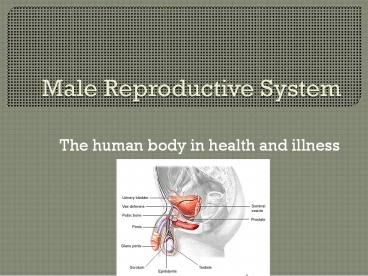Male Reproductive System PowerPoint PPT Presentation
1 / 25
Title: Male Reproductive System
1
Male Reproductive System
- The human body in health and illness
2
Test Diagram of Male Reproduction
3
Male Reproduction
4
Testes
- The most important part of the male reproductive
system are the Testicles (Gonads)
5
Male Reproductive System
- Sperm
- Production
- Nourishment
- Transportation
6
Gonads
- The testes evolve from prenatal sex cells called
Gonads
7
Gonads
- The Gonads begin their development within the
abdominal cavity and usually descend into the
scrotum during the last 2 months of fetal
development. - Failure to descend is called cryptorchidism
- A condition that could result in sterility
8
Testicles
- The two major functions of the testes
- Production of Sperm
- Secretion of Testosterone
9
Testes
- Testes located outside the body and are suspended
in a sac called the scrotum
10
Scrotum
- THE SCROTUM is pouch like structure that houses
the testes and regulates temperature. - This is done in two ways
- 1) Sweating
- 2) Cremasteric Muscle
11
Scrotum
- Sperm cannot live at body temperature (98.6)
- Sperm prefers the temperature of the scrotum
(93.2) - Cold environment the scrotum with the assistance
of the cremasteric muscle contracts the testes
closer to the body maintaining 93.2 degrees - Warm environment Cremasteric muscle relaxes
allowing the testes farther from the body
maintaining 93.2 degrees
12
Sperm Temperature
- Tight underwear or jeans can elevate the
temperature of the testes thereby lowering the
sperm count
13
Spermatogenesis
14
Lobules
- The testes are seperated and divided into Lobules
- Lobules are made up of
- Seminiferous Tubules
- Epididymis.
15
Seminiferous Tubules
- Seminiferous tubules, which is where the actual
production of sperm takes place.
16
Epididymis
- After spermatogenesis the sperm pass into the
epididymis for collection and storage - While in the epididymis the sperm become fertile
and develop the ability to move - The walls of the epididymis contract forcing
sperm into the vas deferens
17
Vas Deferens
- A continuation of the epididymis which travels
through the abdominal cavity and connects with
the duct of the seminal vesicle - Vasectomy
- A cutting of the Vas Deferens causing infertility
18
Urethra
- Extends from the base of the bladder to the tip
of the penis - Carries urine from the bladder to the outside
- Carries semen from Seminal Vesicle to the outside
19
Bulbourethral Gland (Cowper Gland)
- During sexual arousal the gland produces a clear,
viscous secretion known as pre-ejaculate. - This fluid helps to lubricate the urethra for
sperm to pass through. - It also neutralizing traces of acidic urine in
the urethra,and helps flush out any residual
urine or foreign matter.
20
Seminal Vesicles
- Located at the base of the bladder
- Secretes a thick yellowish material rich in sugar
and vitamin C to activate and nourish the sperm
21
Penis
- The penis is the male sex organ for intercourse
and also serves as a urine draining organ.
22
HORMONAL FUNCTION
- The reproductive system is controlled by the
pituitary gland (Master Gland) - In the male, the pituitary gland secretes two
main hormones - FSH FOLLICLE STIMULATING HORMONE
- ICSHINTERSTITIAL CELL STIMULATING HORMONE
23
Follicle Stimulating Hormone
- Stimulates the testes to produce sperm cells
24
Interstitial Cell Stimulating Hormone
- Stimulates testes to produce the primary sex
hormone, testosterone
25
Testosterone
- Testosterone is the male primary sex hormone.
- It is responsible for the male secondary sexual
characteristics - Voice Change
- Masculine Features
- Muscle Development
- Hair Growth
- Attracted to the opposite sex

